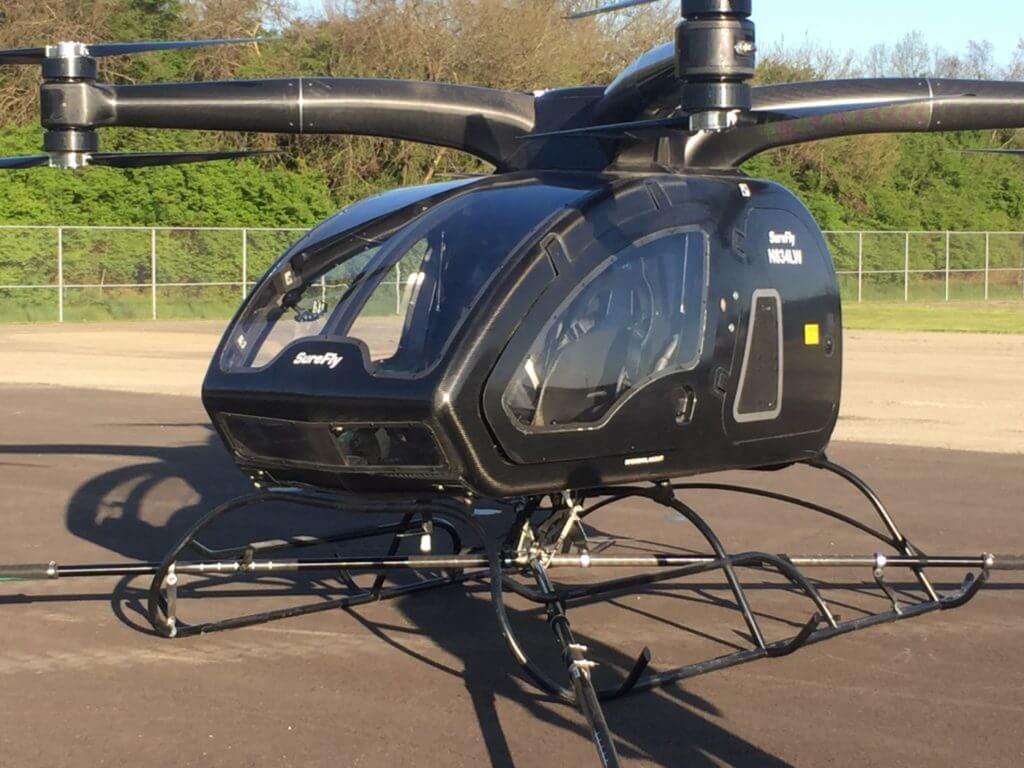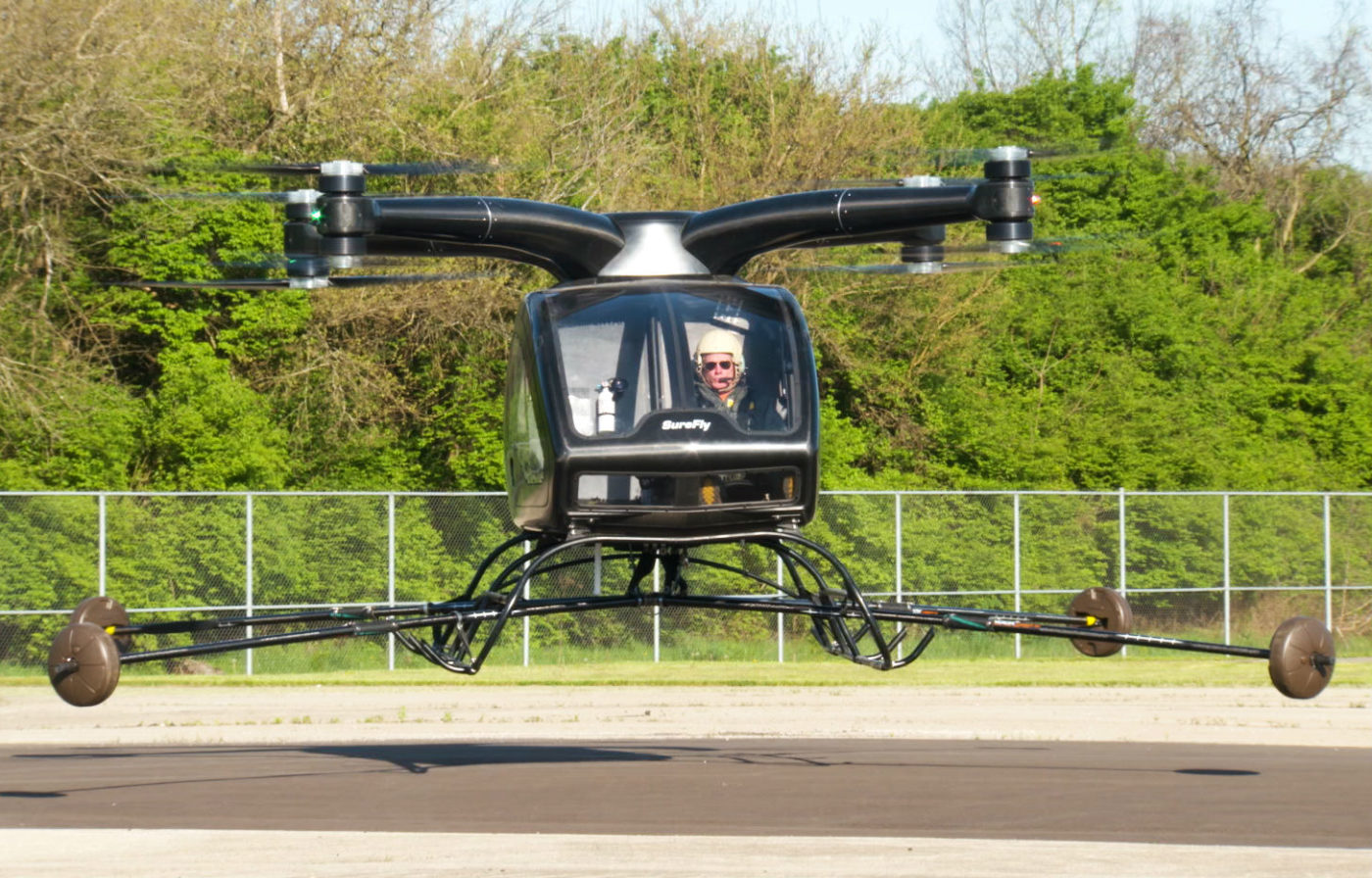The Workhorse SureFly personal vertical takeoff and landing (VTOL) vehicle has completed its first untethered flight — a major step towards a planned certification of the quadcopter-style aircraft in late 2019/early 2020.
The flight, which took place on April 30, lasted about 10 seconds, and was witnessed by officials from the Federal Aviation Administration (FAA). Subsequent flights over the next few days lasted up to 20 seconds, Workhorse co-founder and CEO Steve Burns told Vertical.

Publicly unveiled at the Paris Air Show in June 2017, the SureFly’s design sees a pair of counter-rotating propellers at the end of each of four arms that reach out in an “X” above a compact two-seat carbon fiber cabin. The aircraft is controlled through a joystick for pitch and roll, and buttons for yaw and to change altitude.
“The first [untethered] flight really proved to us what we needed to know,” he said. “The energy used, the audible noise, the ease of control with the joystick, [and] the balancing algorithms. . . . It really is the culmination of about 20 things we had to verify that we’ve been calculating for a long time.”
Burns described the SureFly as a hybrid aircraft in terms of its power source, with a fossil fuel generator and dual 7.5 kWh lithium battery packs that serve as capacitors and emergency backup should the generator fail. Workhorse is developing the SureFly with a 200-horsepower piston generator, but plans to eventually offer a 300-horsepower turbine-powered version, too.
Since the aircraft’s unveiling in Paris last year, it has undergone several changes in design. The most noticeable of these is in the shape of its arms, which have been rounded from their original rectangular design.
“We found that the seams of the prop arms, under long-term vibration of the props . . . started to fail, so we went with round arms,” he said. “They were better for the downwash of the blade and there weren’t any hotspots.”
The SureFly’s monocoque carbon-fiber cabin has also been refined, while the battery and generator have both changed.

“We were going to go with a Honda [generator], but FAA approval with that would have been a long road, and we didn’t envision a turbine at the time,” said Burns.
The piston-powered SureFly is designed to fly up to 75 miles (120 kilometers) at a speed of approximately 75 miles per hour (120 kilometers per hour), with an anticipated empty weight of 1,100 pounds (500 kilograms) and a maximum takeoff weight of 1,500 pounds (680 kilograms).
Burns said the turbine version will be more expensive than the $200,000 piston-powered version, but would offer a greater payload or improved range.
Workhorse believes that price point will make the aircraft appealing to a broad range of customers — many from outside of traditional aviation circles. It began taking deposits for the SureFly during the Paris Air Show, and while it isn’t revealing the number it has received, Burns said it had surpassed the company’s expectations.
“What we kind of learned is, if you have a safe, relatively inexpensive, low maintenance, easy-to-fly machine, a lot of people that would never have dreamed of flying a helicopter will choose this,” he said. “It could be an emergency responder; it could be a farmer checking cattle, or crops; a decision maker; or an air-taxi service. . . . I think we’re bringing aviation to people that previously just weren’t interested in it.”
Layers of redundancy
Making the SureFly a safe product is a high priority for Workhorse, said Burns, with multiple layers of redundancy built into the aircraft’s flight systems. Each propeller is driven by its own motor, and should any of the motors fail, the aircraft will be able to maintain flight with as few as four propellers, he said. If the generator fails, the aircraft has two backup batteries (each powering four motors) that guarantee five minutes’ flight for an emergency landing and, as further backup, the SureFly has a ballistic parachute if required.

“We want to prove that it’s safer to take the SureFly to a destination than to drive your road vehicle to the same destination,” said Burns. “We’re trying to make this the safest personal aviation machine ever made — and we understand that’s a big statement.”
Indeed, proving the aircraft’s safety is a key part of the journey toward certification, and the FAA has been playing close attention to the project’s development.
Burns said Workhorse has made “a lot of progress” with the regulator in moving towards type certification and establishing what kind of credentials would be required to fly it. The former is likely to require a new certification category, he said.
“New certification is double speak to me for long and expensive, but we’ve really found the FAA to move at lightspeed for us, and if we can prove it’s safe, they’re open to new types of vehicles,” he added.
As for piloting the aircraft, Workhorse hopes to have “something similar” to a light sport aircraft rating, requiring about 20 hours of type instruction.
Workhorse is taking the SureFly through the certification process as a manned aircraft, but is building it to ultimately be capable of autonomous flight.
“I think it’ll probably go like how autonomous cars are going, or really like autopilot is like in any jet you go in,” said Burns. “But to get certified, right now, it’s a piloted aircraft.”
The aircraft is just one contender in an increasingly packed field of personal VTOL aircraft, going up against the likes of the Volocopter 2X and Ehang 184, as well as heavily financed efforts from manufacturing giants Airbus (CityAirbus) and Bell (Urban Air Taxi). But Burns isn’t daunted by the competition, pointing to Workhorse’s background in manufacturing electric pickup trucks for the last 10 years, in which it has gone in direct competition against some of the largest automobile manufacturers in the world.
“Although we’re making vertical takeoff and landing machines, we are coming at it in vastly different ways,” he said. “We’ve taken this approach of a super simple design, everything is fixed, nothing moves, and we think it’s fastest to certification, easiest to fly, and least cost.”
Workhorse plans to bring the aircraft to the EAA AirVenture Oshkosh tradeshow in Wisconsin, July 23 to 29, where it hopes to be able to demonstrate the aircraft in flight.










75 mile range at 75 mph, I don’t see the mission.
Paul’s never seen the traffic in L.A., or NYC, or Houston
When is your next video release showing significant free flight images new body design plus information on current engine selection and anticipated range. Have you appointed an Agent in Australia and when do you expect to start production for sale to the public for private use.Please put me on your email list for future updates
Great achievement. Congratulations. I would like to make a deposit to purchase this drone vehicle.
Have you appointed an Agent in Australia and when do you expect to start production for sale to the public for private use.Please put me on your email list for future updates.
Great achievement. Congratulations. I would like to make a deposit to purchase this drone vehicle.
I made a typo.
Mexico instead of Australia.